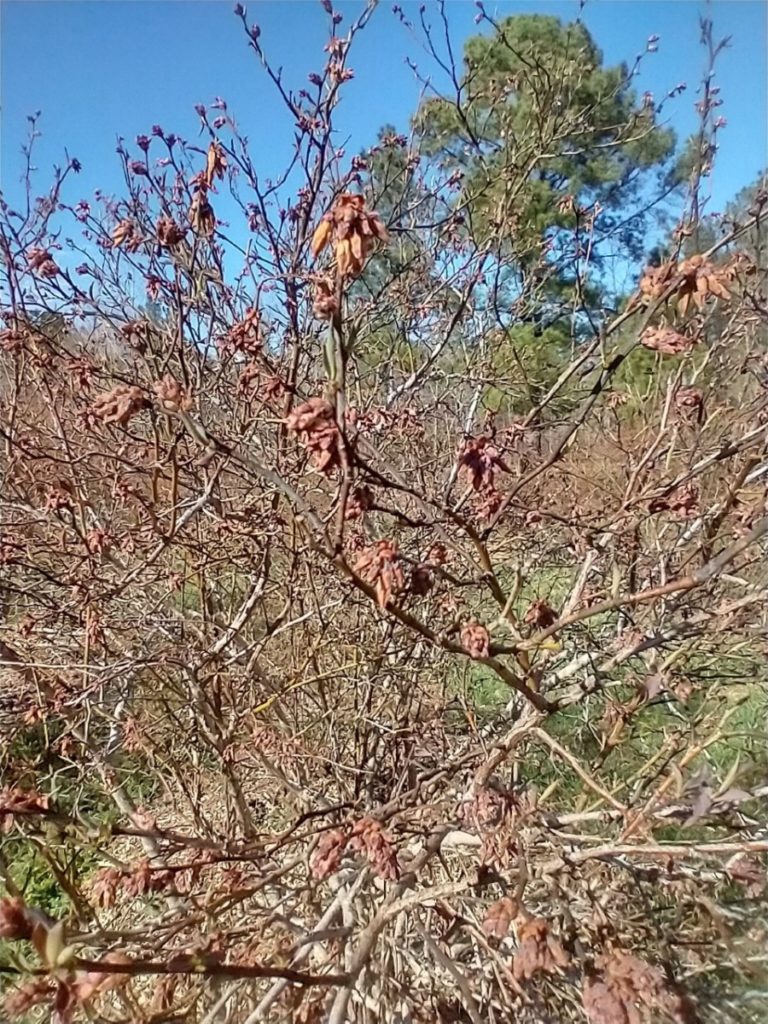This week farmers and extension agents were hard at work across Georgia and other Southeastern states assessing the damage from the frost on Sunday, March 13. Here is a brief summary of the comments I have received from my colleagues and friends on what they have seen. Keep in mind that some frost damage, particularly to young trees that have been recently planted, may not be visible for several months so these observations do not cover all of the damage that may have occurred. There are all my own impressions based on what I heard from others, so if I got something wrong, it is my fault. I am still learning about frost impacts on agriculture. Thanks to all the folks who took the time to let me know what they were seeing, it was very helpful and eye-opening. I would be happy to hear any other reports, too, to give a more complete picture of what happened.
Corn: From what I have heard, corn that had emerged received some frost burn to the leaves, but the growing point was below the surface and so the corn should grow out of it over time once they push through the dead leaves. Farmers will need to assess how much of a loss they experienced and will have to decide if they need to replant, but yields go down the later you plant so this is not an ideal solution. Sweet corn in SW Georgia did experience some losses.
Peaches: In middle Georgia, the peaches came through better than expected. Early blooming varieties were the hardest hit, and later blooming varieties managed to squeak through in many areas. The losses for some orchards were not much different than the thinning they would have to do anyway, so it may not be a significant loss.
Pecans: The pecan trees were starting to bloom on the lowest branches and those may have been nipped by the frost, but most blooms were not open yet and so had protection from the cold temperatures. Newly planted trees are likely to have experienced severe damage to the cambium that would affect their ability to circulate water but that may not show up until mid-summer.
Blueberries: Temperatures in central Georgia reached as low as 20 F for several hours, and it is difficult to do adequate frost protection when the cold lasts for that long. As a result, many blueberries in that part of the state are not expected to produce a viable crop this year. Blueberries farther south experienced somewhat milder temperatures and growers were able to use some frost protection with irrigation, although the results varied depending on irrigation system, location of the field, and wind speed. The Southern highbush varieties had berries and those had the most significant losses. The later rabbiteye bushes were blooming and were somewhat less affected. I am sure there will be losses, but growers have been watching their fields to see how many blooms appear. I have heard that some farmers experienced a loss of 75% or more but they are still assessing.
Strawberries: Some strawberries had mild damage where uncovered, or even when they were covered in more northern areas. That may delay first harvest for a week or two.
Vegetables: Squash and cabbage were hit pretty hard in SW Georgia as well as some transplants, but many warm season vegetables had not been planted yet. Home gardens farther north experienced the worst frosts and many gardeners who started their gardens early will likely have to replant. I also got reports that there was some leaf damage to Vidalia onions but that was not expected to cause significant losses to the crop. Newly planted watermelon plants in northern Florida survived better than expected due to a combination of covers and a temperature a little higher than originally forecast.
Small grains felt limited effects, with the plants that had exposed flowers experiencing the biggest losses. Canola took a 20% hit in some areas.
